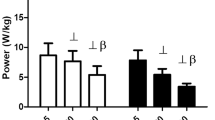Summary
A systems model, providing an estimation of fatigue and fitness levels was applied to a 1-year training period of six elite weight-lifters. The model parameters were individually determined by fitting the predicted performance (calculated as the difference between fitness and fatigue) to the actual one. The purpose of this study was to validate the systems model by comparing the estimated levels of fatigue and fitness with biological parameters external to the model calculation. The predicted and the actual performances were significantly correlated in each subject. The calculated fitness and fatigue levels were related to serum testosterone concentration, testosterone: cortisol and testosterone: sex hormone binding globulin ratios. The best results were obtained by the comparison between fitness and testosterone levels, which varied in parallel in each subject. In two subjects this correlation was significant (r=0.91, P<0.05, and r=0.92, P<0.01). The fitness changes calculated in each subject between the 15th and the 51st weeks of training were significantly correlated with the changes in serum testosterone concentration measured in the same period (r=0.99, P<0.001). For the whole group testosterone and fitness variations were also significantly intercorrelated (r=0.73, P<0.001). Correlations, less homogeneous and less significant, were calculated also for other hormones and ratios. These results suggest that (1) the relationships between training and performance can be described by the systems model, (2) the estimated index of fitness has a physiological meaning. The fatigue index remains to be clarified.
Similar content being viewed by others
References
Alen M, Pakarinen A, Häkkinen K, Komi PV (1988) Responses of serum androgenic-anabolic and catabolic hormones to prolonged strength training. Int J Sports Med 9:229–233
Banister EW, Hamilton CL (1985) Variations in iron status with fatigue modelled from training in female distance runners. Eur J Appl Physiol 54:16–23
Calvert TW, Banister EW, Savage MV, Bach T (1976) A systems model of the effects of training on physical performance. IEEE Trans Syst Man Cybern SMC 6(2):94–102
Durnin J, Rahaman M (1967) The assessment of the amount of fat in the human body from measurements of skinfold thickness. Br J Nutr 21:681–689
Glowinski R, Lions JL, Tremoliere R (1976) Analyse numérique des inéquations variationnelles. Dunod, Paris
Hakkinen K, Pakarinen A, Alen M, Komi PV (1985) Serum hormones during prolonged training of neuromuscular performance. Eur J Appl Physiol 53:287–293
Häkkinen K, Pakarinen A, Alen M, Kauhanen H, Komi P (1987) Relationships between training volume, physical performance capacity, and serum hormone concentrations during prolonged training in elite weightlifters. Int J Sports Med [Suppl] 8:61–65
Häkkinen K, Pakarinen A, Alen M, Kauhanen H, Komi PV (1988a) Neuromuscular and hormonal adaptations in athletes to strength training in two years. J Appl Physiol 65:2406–2412
Häkkinen K, Pakarinen A, Alen M, Kauhanen H, Komi P (1988b) Daily hormonal and neuromuscular responses to intensive strength training in 1 week. Int J Sports Med 9:422–428
Kuoppasalmi K, Naveri H, Harkonen M, Adlercreutz H (1980) Plasma cortisol, androstenedione, testosterone and luteinizing hormone in running exercise of different intensities. Scand J Lab Invest 40:403–409
Author information
Authors and Affiliations
Rights and permissions
About this article
Cite this article
Busso, T., Häkkinen, K., Pakarinen, A. et al. A systems model of training responses and its relationship to hormonal responses in elite weight-lifters. Eur J Appl Physiol 61, 48–54 (1990). https://doi.org/10.1007/BF00236693
Accepted:
Issue Date:
DOI: https://doi.org/10.1007/BF00236693




